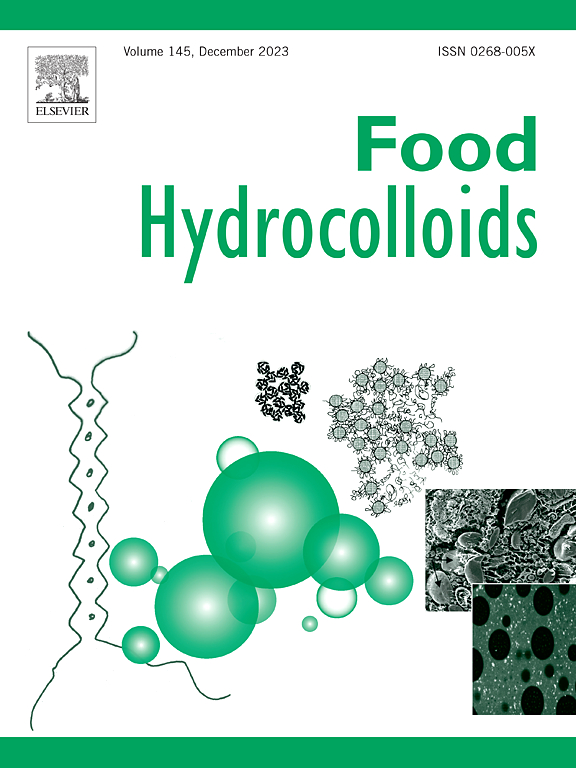Water-insoluble citrus fiber enhances the textural properties and water-holding capacity of thermally generated kappa-carrageenan gels via skeletal reinforcement
IF 11
1区 农林科学
Q1 CHEMISTRY, APPLIED
引用次数: 0
Abstract
Kappa-carrageenan (KC) is widely used in gelled food formulations due to its gelling properties. However, practical applications of KC gels are hindered by their brittleness and high water separation rates. This study presents an innovative strategy that utilizes water-insoluble citrus fiber (ICF) to improve the stability and water-holding capacity (WHC) of KC gel. The incorporation of ICF significantly improved the textural properties of KC gels; for example, it increased their hardness and chewiness. The optimal WHC was achieved at the concentration of KC was fixed at 4 %, and ICF accounted for 50 % of the mass of KC. Rheological analyses revealed a proportional increase in the storage modulus with the ICF content (p < 0.05), which indicated the formation of more robust gel structures. Fourier transform infrared spectroscopy confirmed the occurrence of hydrogen bonding interactions between KC and ICF. Scanning electron microscopy images highlighted that a compact gel network was formed by ICF filling the KC matrix. X-ray diffraction an further demonstrated increase in crystallinity, and atomic force microscopy analysis revealed that the gel surface became rougher upon the addition of ICF addition. These findings demonstrate that ICF effectively improves the structural and textural properties of KC gels, and thus underscore its potential as a desirable gel modifier in food applications.

求助全文
约1分钟内获得全文
求助全文
来源期刊

Food Hydrocolloids
工程技术-食品科技
CiteScore
19.90
自引率
14.00%
发文量
871
审稿时长
37 days
期刊介绍:
Food Hydrocolloids publishes original and innovative research focused on the characterization, functional properties, and applications of hydrocolloid materials used in food products. These hydrocolloids, defined as polysaccharides and proteins of commercial importance, are added to control aspects such as texture, stability, rheology, and sensory properties. The research's primary emphasis should be on the hydrocolloids themselves, with thorough descriptions of their source, nature, and physicochemical characteristics. Manuscripts are expected to clearly outline specific aims and objectives, include a fundamental discussion of research findings at the molecular level, and address the significance of the results. Studies on hydrocolloids in complex formulations should concentrate on their overall properties and mechanisms of action, while simple formulation development studies may not be considered for publication.
The main areas of interest are:
-Chemical and physicochemical characterisation
Thermal properties including glass transitions and conformational changes-
Rheological properties including viscosity, viscoelastic properties and gelation behaviour-
The influence on organoleptic properties-
Interfacial properties including stabilisation of dispersions, emulsions and foams-
Film forming properties with application to edible films and active packaging-
Encapsulation and controlled release of active compounds-
The influence on health including their role as dietary fibre-
Manipulation of hydrocolloid structure and functionality through chemical, biochemical and physical processes-
New hydrocolloids and hydrocolloid sources of commercial potential.
The Journal also publishes Review articles that provide an overview of the latest developments in topics of specific interest to researchers in this field of activity.
 求助内容:
求助内容: 应助结果提醒方式:
应助结果提醒方式:


